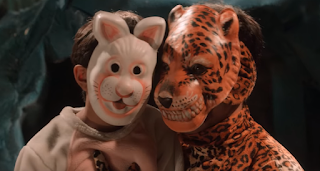In my Economic Times column, thoughts on beasts and men (or victims and predators) in an enjoyable new crime series Aranyak, a 1940s B-horror film and Jane Campion’s new Western
--------------------
The opening image of the new series Aranyak involves a movement from a dark space to a well-lit one: the camera follows a man in a leopard costume through a “cave” onto the stage of an auditorium where fond parents are watching a school production. It’s fun and games at first, but then the music becomes minatory, there are unsettling close-ups of the “leopard” holding a “rabbit”, and we realise that this is a performance within a performance. A human, mimicking a predatory animal, turns out to be a predator himself.
Structurally, Aranyak is comparable to the acclaimed series Mare of East Town, which is also a crime investigation with a solid lead role for a middle-aged actress (Kate Winslet), and set in a place where everyone knows everyone else – resulting in a tangled weave of suspects, personal histories and interrelated motives. But one of the joys (and hazards) of being a full-blown movie nut is how often you see connections between generally unrelated works: how a similarity of name, or a character arc, or just a particular scene, can lead you down various rabbit-holes. Or leopard-caves. Just one whimsical example: watching a scene involving a cute rabbit – fussed over but eventually disembowelled for medical purposes – in Jane Campion’s new film The Power of the Dog, I thought of the kidnapped “Rabbit” in Aranyak. The Campion scene was also a reminder of the different contexts in which someone can be victim or prey: the bunny-killer is a shy, bullied young man who we are meant to be rooting for but who turns out to be steelier than expected. (Along similar lines, Aranyak ends with the suggestion – heralding a second season – that the “victim” from its opening scene may have become a threat.)
Much as I liked the threads that jostle for our attention over Aranyak’s eight episodes, I also fixated on a specific aspect of it: the repeated references to the much-feared “nar-tendva” – or “leopard man”, as the subtitles had it. This had me thinking about a 1943 film by that name, produced by Val Lewton, who was a master of low-budget psychological horror in that decade.
Once a broad connection between two such works is made, other little things fall in place. Both film and show make references to wild creatures wanting to stay away from concrete and cement dwellings unless they have no other option. If the real leopard in Aranyak looks like a CGI creation (hence not “scary” to the eyes of discerning viewers), the black leopard shown in The Leopard Man is underwhelming too: it looks puny and out of its depth in a scene where a nightclub performer brings it (on a leash!) to a crowded party. In both cases, though probably unintended, the effect is that the relative harmlessness of the “wild creature” is emphasized. The bigger menace, as is often the case, comes from humans – especially when they combine the feral side of their natures with the big-brained ability to contrive and manipulate. Run, rabbit, run.
Sunday, January 09, 2022
Mix and match: Aranyak, The Leopard Man, The Power of the Dog
Subscribe to:
Post Comments (Atom)
No comments:
Post a Comment